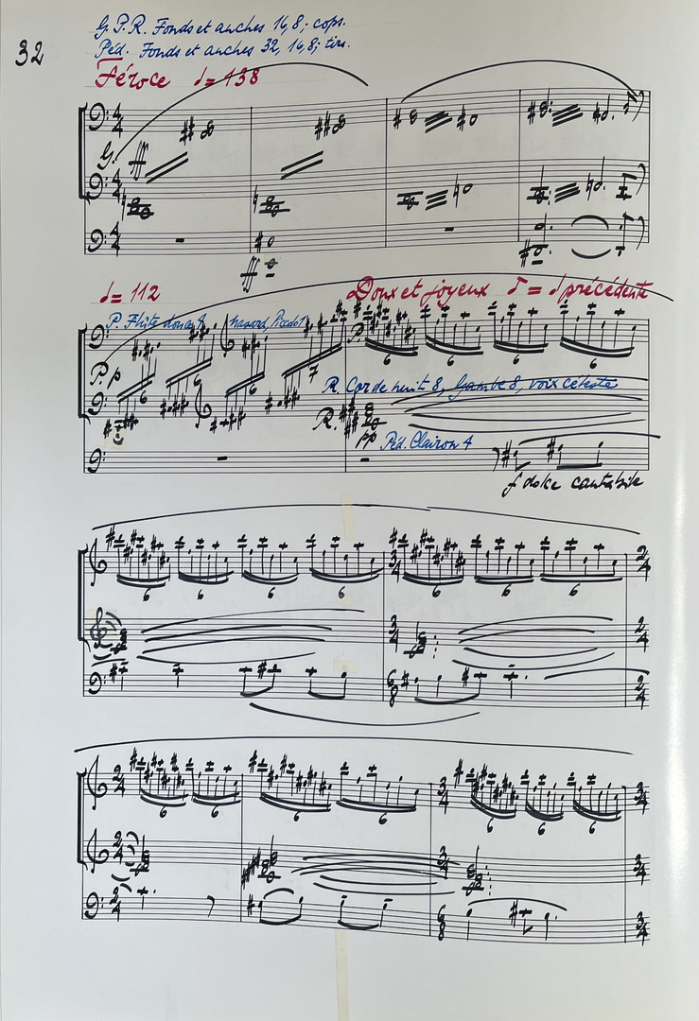
The last Judgment
Title, Duration, Place, Year, Publisher, Dedicated to, Premiere (performer(s), place, date)
THE LAST JUDGMENT, 20', Bayonne, 1999, Leduc, to Joseph Adam, Joseph Adam, St James' RC Cathedral, Seattle, 09.06.00)
The Last Judgment is a through-composed symphonic tableau that follows the structure of the text of Matthew 25 : 31-46, underlining it in a figuralistic manner. Other scriptural references are also to be found: an image of the sun that turns dark (Acts of the Apostles 2: 20), and, before the gathering of the nations, twelve chords representing the thrones for the judgment of the twelve tribes of Israel (Matthew 19: 28). The thematic material combines original figures with Gregorian chant: the Gloria from the Missa de Angelis; the Alleluia of the Epiphany; Dies irae, the sequence from the Requiem Mass; In paradisum, the burial antiphon. The sections in recitative style follow the declamatory rhythm of the corresponding verses in Arabic, the composer’s mother tongue. Finally, the registration requires a symphonic style organ such as the Goll organ in Memmingen, Germany, at which the composer prepared the orchestral expression of this work.
The Last Judgment (Le Jugement
dernier) est un tableau symphonique en composition continue; son discours suit la structure du texte de Matthieu 25 : 31-46, qu'il souligne de manière figuraliste. On y trouve également d'autres
évocations scripturaires : au départ, image du soleil qui se transforme en ténèbres (Actes des Apôtres 2:20) et avant l'assemblée des nations, douze accords figurant les trônes pour le jugement des
douze tribus d'Israël (Matthieu 19:28). La thématique conjugue un matériau libre à des sources grégoriennes : Gloria de la Missa de Angelis, Alleluia de
l'Epiphanie, Dies irae, séquence de la messe des morts, In paradisum, antienne des enterrements. Les périodes en style de récitatif suivent le rythme déclamatoire des
versets correspondants en arabe, langue maternelle du compositeur. Enfin, la registration requiert des instruments de type symphonique, tel le grand-orgue Goll de Memmingen (Allemagne), dont l'auteur
fit usage pour achever l'expression orchestrale de l'oeuvre.
The Last Judgement es handelt sich um ein durchkomponiertes symphonisches Tableau, dessen musikalischer
Verlauf unter strukturellem Aspekt dem Text des Matthäus-Evangeliums 25 :
31-46 folgt und diesen figurativ ausdeutet. Gleichwohl finden sich auch andere Anspielungen auf die Heilige Schrift: so zu
Beginn das Bild der in Finsternis sich verkehrenden Sonne (Apostelgeschichte 2, 20) oder - kurz bevor die Versammlung der Völker zur Darstellung gelangt - zwölf Akkorde, die die zwölf Stëhle
symbolisieren, von denen aus die zwölf Stämme Israels gerichtet werden (Matthäus 19, 28). Das thematische Material ist teils frei gewählt, teils entstammt es gregorianischen Quellen:
dem Gloria der Missa de Angelis, dem Alleluja zur Epiphanie, der Sequenz der Totenmesse, Dies irae, und der
Begräbnisantiphon In paradisum. Die rezitativischen Abschnitte folgen dem Sprachrhythmus der entsprechenden Verse im Arabischen, das die Muttersprache des Komponisten ist. Die
Registrierung schließlich erfordert ein großes Instrument romantischen Typs wie etwa die Goll-Orgel in Memmingen, an der der Komponist die orchestrale Disposition des Werkes
entwickelte.

